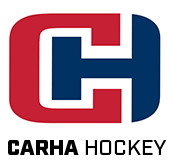Many claim that Canada was the birthplace of hockey, and few would dispute that it is Canada’s official winter game. The passion for this fast-paced sport runs deep in every community. The relationship between hockey and our country’s military dates back more than a century. In fact, it is believed that hockey actually had its origins in the military. To play the game at competitive levels, you need to be in great physical shape. It is therefore not surprising that many young Canadians who played hockey also enlisted during the First World War.
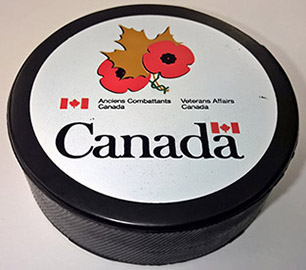
First World War
Military hockey teams were created across Canada early on in the war. There were games between battalions, games between military members and civilians, and well-known matches in which the navy faced the army. Military hockey teams attracted lots of attention, such as the 228th Battalion (Northern Fusiliers) who even played in a professional league. As the war dragged on, more and more men were needed on the front lines. Hockey themes were even used in posters to encourage military service! Large number of young men ended up enlisting, creating a void in many arenas and women’s hockey suddenly became very popular.
There is no official count on the number of hockey players who served in the Great War, but more than 30 Canadians who perished in that war had significant ties to hockey. Memorial awards were created for many of these men, such as the Abbott Memorial Cup, to honour Edward Lyman Abbott, as well as the George Taylor Richardson Memorial Trophy. The tragic loss of prominent hockey players such as Allan “Scotty” Davidson and George Richardson inspired Captain James Sutherland and businessman Liam Carr to create a trophy to pay tribute to all Canadians who died at war.
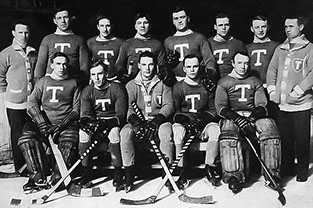
The Memorial Cup was first awarded in 1919, one year after the end of the First World War. It is now awarded each year to the junior hockey champions of the Canadian Hockey League. The cup was donated in 1919 by the Ontario Hockey Association. Since then, the format of the tournament to decide the winner of the cup has been altered a few times, but a key element remains—it is always a powerful symbol of remembrance. At the 2010 Memorial Cup Tournament, held in Brandon, Manitoba, the championship trophy was rededicated to recognize Canada’s war dead from all conflicts. Veterans from the Second World War and the Korean War escorted the Memorial Cup in a touching ceremony that took place at CFB Shilo.
Few Canadian hockey teams have won gold at the Olympic Games. For the Winnipeg Falcons, this accomplishment was even more special due to the fact that seven of its players served during the First World War. Sadly, Frank Thorsteinson and George Cumbers lost their lives, and by coincidence, they both are buried in the Barlin War Cemetery in France. This tough blow did not prevent teammates Wally Byron, Frank Fredrickson, Konnie Johannesson as well as brothers Bobbie and Harvey Benson to don the skates during the war and play on their battalion’s team. After the war, the Winnipeg Falcons team was put back together and they went on to win the Allan Cup in 1919-1920, making them the national senior amateur men’s ice hockey champions of Canada. This title granted them the right to represent Canada at the 1920 Olympics games in Antwerp, Belgium. The first Winter Olympics (better suited for hockey!) would be held four years later. The victorious Falcons brought home Canada’s first-ever Olympic gold medal in hockey.
Second World War
During the Second World War, many National Hockey League players put their careers on hold to serve in the military. Most players, though, did not enlist as dramatically as Milt Schmidt, Woody Dumart and Bobby Bauer. The three forwards for the Boston Bruins’ best line, ironically nicknamed the ”Kraut Line” because of their German ancestry, hung up their skates and enlisted together in the Royal Canadian Air Force on the same day in 1942. The fans went wild! All three saw action overseas as aircrew. Fortunately they survived the war and returned to the NHL, but not before they had given up three and a half years of their hockey careers to serve in the cause of peace and freedom. The teammates hadn’t lost their hockey flair and helped the Bruins reach the Stanley Cup finals in 1946.
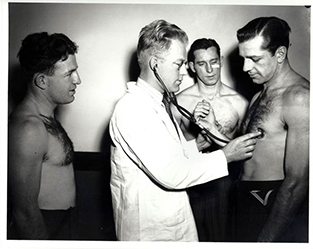
In Toronto, co-owner of the Maple Leafs, Conn Smythe (who had been decorated for bravery in the First World War) enlisted again at age 45. Leading by example, many Maple Leaf players also decided to join the war effort. Smythe was commanding an artillery battery in France when he was wounded in an enemy bombing attack. To this day, the National Hockey League trophy for the most valuable player in the playoffs is named in his honour. As Veteran Gordie Bannerman recalled in his memoirs, “Turk Broda of the Leafs and a few more NHL chaps were just overseas and had the help of Conn Smythe, Leafs owner, who commanded an artillery battery. Orme Payne, Sparky Ament, Darcy Spencer, Bob Bradley, and a couple more of our chaps, plus 5th LAA personnel were off to Amsterdam to play hockey. The fellows had a pretty good few weeks in the city of canals.”
Some players, like Maurice “Rocket” Richard, could not enlist because of injuries they had received during their hockey careers. Other players enlisted but did not make it to the front lines. Having them play hockey either in Canada or in military camps overseas proved to be a pillar of strength for both civilians and the military. Highly competitive regimental hockey teams were formed, serving such purposes as keeping the men fit and entertaining the serving members on military bases.
The war also had a huge impact on the Canadian economy. Various peace-time factories were converted to supply much needed products for the war effort. For example, the Canadian Cycle and Motor Co. Ltd. of Weston, Ontario, which had made bicycles and hockey skates before the war, took over the manufacture of armaments including gun parts, tripods for Bren guns, and cradles and pivots for anti-tank guns.
While firm numbers are elusive, hundreds of Canadian hockey players from all leagues would end up serving during the Second World War and sadly, more than 50 would not survive.
Following the Second World War, the 1948 Winter Olympic Games were held in St. Moritz, Switzerland. Many of the players on the Royal Canadian Air Force Flyers hockey team, representing Canada, were Veterans of the war. Despite a challenging tournament, the men finished in first place. In 2000, the 1948 Royal Canadian Air Force Flyers’ gold medal win was selected as the ”greatest moment in Canadian Armed Forces sports history” and the team was inducted into the Canadian Olympics Hall of Fame in 2008.
Korean War
Our Canadian service members’ love of blending hockey with military service would continue in the Korean War. As the conflict progressed and the front lines became more stationary, our soldiers would find a way to play hockey in the Far East. During the colder months, they would clear the snow covering the ice on the Imjin River and play as the sound of artillery fire boomed in the distance. The matches often saw different units square off, with pride and bragging rights on the line! On March 11, 1952, for example, players from the 1st Battalion of the Princess Patricia’s Canadian Light Infantry and the 2nd Battalion of the Royal 22e Régiment faced off in a well-remembered game. These kinds of sporting events helped bring a little normalcy to our troops serving so far from home in war-torn Korea.
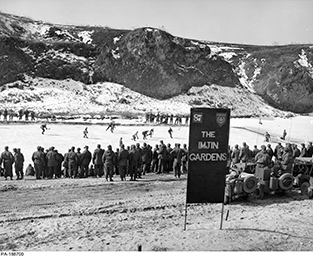
Post-war years
During the post-war years, many military bases across Canada built rinks to allow soldiers, sailors and airmen to play hockey for recreational and training purposes. Not surprisingly, the old military-hockey connection has continued in more recent times. Hockey sticks are sometimes packed when Canadian troops deploy in conflict zones. For example, in Kandahar, Afghanistan, where temperatures often reach 40°C, Canadian Armed Forces members built ball-hockey rinks. They played mostly at night, when the cooler temperature allowed for a faster-paced game. Former NHL players and celebrities like Guy Lafleur, Lanny MacDonald, Bob Probert and Don Cherry even went overseas to visit the troops, some of them playing exhibition games in mixed teams made up of hockey legends and serving members. But a hockey game wouldn’t be the same without referees, so former NHL officials were also on site to oversee the game!
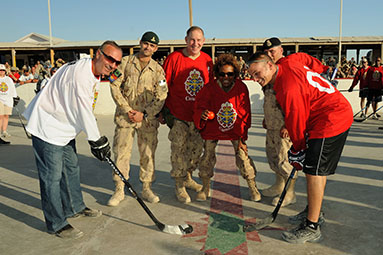
Hockey in the desert was helping boost the morale of our military but Afghanistan was a dangerous place to serve, and sadly some 158 CAF members lost their lives there during the course of our country’s 2001-2014 mission in the country. Many of our service members came back wounded, and stories of severely injured soldiers like Dominic Larocque demonstrate yet again the ties between hockey and the military. Losing a leg in Afghanistan, Larocque went through rehabilitation and was introduced to sledge hockey where he performed so well that he was selected to represent Canada in international competitions including the Paralympic Games. The team won a bronze medal in Sochi, Russia in 2014.
Today, many NHL teams have special games to honour the men and women in the Canadian Armed Forces. It is common to see professional athletes wear camouflage jerseys in warm-ups before those games and goaltenders sometimes play with specially-painted helmets that pay tribute to military members. Junior hockey teams design commemorative hockey jerseys, especially when playing in the Memorial Cup tournament. Ceremonial puck drops involving our men and women in uniform are held across Canada at all levels.
During wartime, hockey was a way for people to momentarily escape from the hardships of war. Next time you watch a hockey game, why don’t you take a moment to think about the heroes of yesterday and today who make it possible for us to enjoy the peaceful society we have in our country?
Original Article published on Veterans Affairs Canada website
History – Hockey and the Canadian military – Remembering those who served – Remembrance – Veterans Affairs Canada: History of hockey and the Canadian military